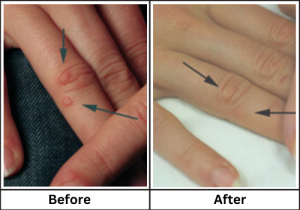The common wart has plagued mankind for centuries. Even today it remains a bit of a mystery as to why some people struggle with warts and others don’t. Despite the widespread affliction of warts (over 2.6 million people in the U.S.), we still don’t have full proof treatments or a cure.

Verrucae is the medical term for warts. If you have or have had them, you know what a pain they can be. They most commonly affect the hands and feet, but any body part with skin can develop a wart. HPV or human papilloma virus causes them, and there are hundreds of different strains of HPV. One less commonly affected area that doctors often misdiagnose is the face. Facial warts can affect younger people. They erupt suddenly and look like pimples—just a few millimeters in diameter and pink to flesh colored. People can group them together or notice them appearing in a linear (in a line) fashion; others might observe them scattered in various areas of the face. Since they’re viral, they don’t get better with acne medications or treatments.
No matter where warts appear, most people with them want them gone fast. It seems like it should be an easy task, but warts can be remarkably stubborn and resistant to treatment. They are frustrating to both patients and practitioners! Some of the more popular wart treatments include freezing (cryotherapy) and irritation with things like salicylic acid solutions. Many people want to surgically remove them, but “cutting out” infection doesn’t always mean it will go away, and despite the availability and popularity of “natural” and “alternative” treatments for warts, there isn’t much evidence to show that any of these really work at all or are even safe to use.
An alternative to traditional treatments is class IV medical lasers. Two specific lasers we use are the pulsed dye and q-switched, most often in combination. You are probably wondering how a laser can treat a viral infection. It’s a great question and one that has a pretty cool answer! Lasers work for viral warts by destroying the blood vessels in the infected skin and generating sufficient heat to interfere with viral replication. If there’s no blood supply, the skin is basically uninhabitable for the wart and virus can no longer continue to grow. This treatment is totally different for this reason, because it is a very specific and predictable way to get rid of warts (unlike painful freezing or other topical methods where it’s more hit or miss).
If you’re thinking that laser treatment is painful, it really isn’t! Treatment is fast—usually only a few minutes to complete. We can safely use our lasers to treat warts on any skin type (color), and although there is no magic number of treatments that guarantees complete removal, we typically eliminate most warts with 1-3 treatments.
You’re probably wondering why more offices don’t offer laser treatment of warts? The reason is that lasers are expensive, and if a practice can’t (or doesn’t know how to) use them for anything else, it’s not cost effective to have one. They also require extensive knowledge of laser medicine to operate and use safely and effectively. This type of training and experience isn’t practical for many of the different medical specialties that see patients with warts.
Here at Celibre Medical, we are experts at using lasers for everything they can be used for—even warts. We’ve seen the dramatic improvement that patients can have despite failing many other types of treatments. If you’re frustrated by the slow (or lack of) progress with your current wart therapy, consider lasers—just make sure your treating practitioner has plenty of expertise in their use.

